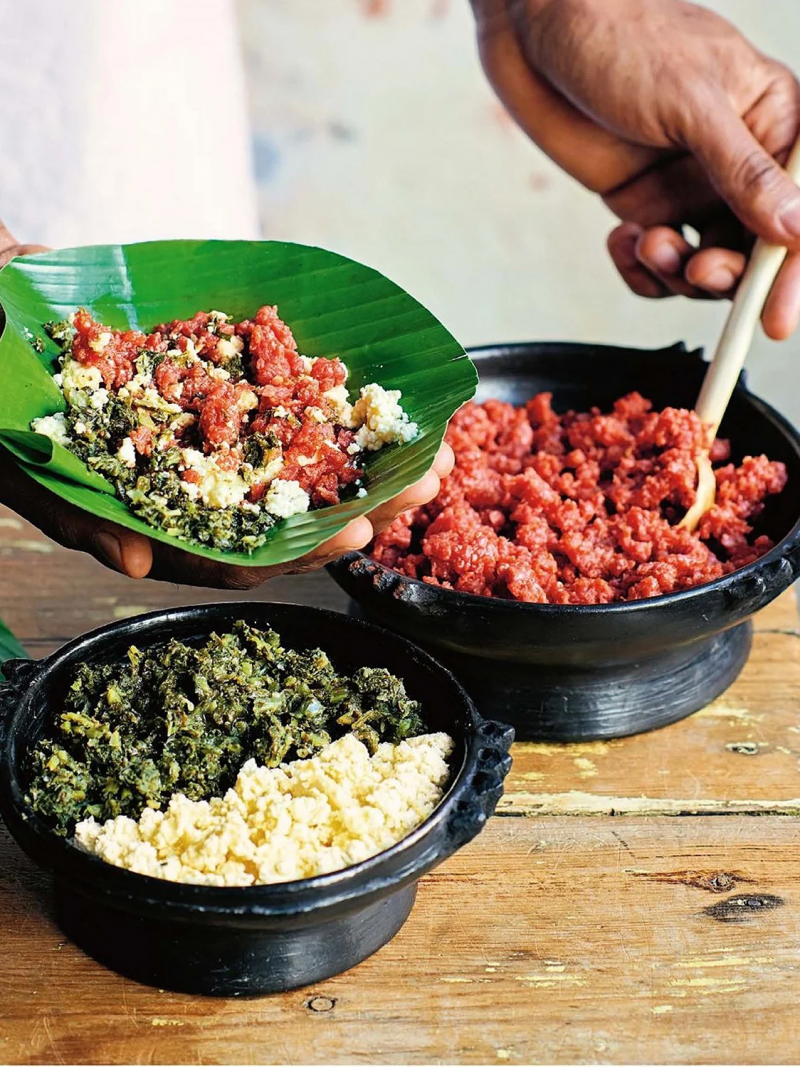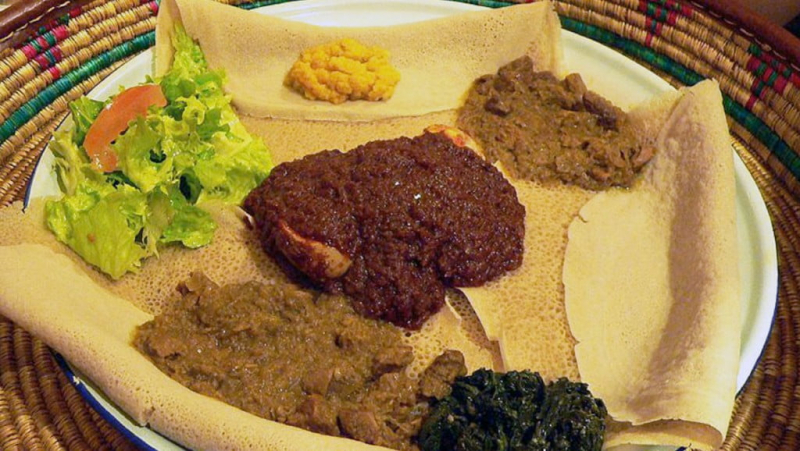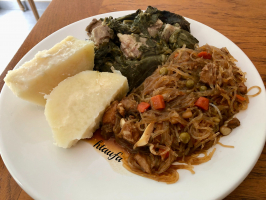Top 7 Best Food In Ethiopia With Recipe
Ethiopian food is distinctive and delicious, befitting a remarkable country with a cultural heritage that stands out from the rest of Africa. While the cuisine ... read more...of Ethiopia is gradually becoming better known, it's no overstatement to say it remains one of the world's best-kept secrets. Eating Ethiopian-style means rethinking many assumptions you might have about dinnertime, this means starting with eschewing cutlery and being ready to get messy fingers. Here is a list of the best dishes in Ethiopia
-
Tibs is a famous Ethiopian dish consisting of sliced beef or lamb pan-fried with butter, garlic, and onion. It comes in a variety of shapes and sizes, depending on the type, size, and shape of the meat slices used, and can be spicy or mild, with little to no vegetables. Shekla tibs, in which the strips of beef arrive at your table roasting on a clay pot heated with hot coals, is a particularly recommended variation.
Tibs was traditionally provided to pay someone a compliment or demonstrate respect. It's still considered a special dish today, which explains its appeal as a way to commemorate important occasions and holidays. On the other hand, if you stroll into a loud pub in Ethiopia's raucous capital, Addis Ababa, on a Friday afternoon, it's probable that the majority of the patrons will be ordering and eating tibs. The tibs meat that comes at your table has usually just been sliced from corpses hanging outside the restaurant's entryway. Don't be turned off; beef doesn't get any fresher or tastier than this.
Ingredients
- 5 tablespoons niter kibbeh, or plain unsalted butter, 2 medium onions, chopped medium (about 2 cups), 3 inch knob ginger, minced, about 2 tablespoons, 6 medium cloves garlic, minced, about 2 tablespoons, 2 tablespoons berbere (see note), Kosher salt, 1 pound beef sirloin, cut into 1-inch cubes, trimmed of excess fat and connective tissue, 1 teaspoon vegetable oil, 1 teaspoon lemon juice, to taste
Directions
- In a heavy saucepan over medium heat, melt niter kibbeh or butter, then add onions, ginger, garlic, and berbere. Reduce heat to medium-low and simmer, stirring periodically, for 30 minutes, or until onions are dark, reddish, and golden. During the cooking process, onions should have a low sizzle. Heat should be adjusted as needed. Blend in a food processor until it's almost a purée. Return to the pot, season with salt and pepper to taste, and keep heated.
- Season the steak with kosher salt on all sides. In a 12-inch cast iron or stainless steel skillet, heat the oil over high heat until it begins to smoke. Add the beef in a single layer, leaving plenty of room in the pan (if you don't have a large enough skillet, brown in batches). Cook for 3 minutes without moving until well-seared on one side. With tongs, flip the meat cubes and cook on the other side until fully seared. Cook the meat, stirring and flipping occasionally, until it reaches the desired amount of doneness. Transfer the meat to a pot right away if you want it rare. Cook for another one to two minutes on medium before transferring to a saucepan. Cook for another five minutes if you want it well done before transferring to a saucepan.

Photo: tasty.co 
Photo: 196flavors.com -
Kitfo, which is made from the leanest meat, is regarded as a special pleasure by regular Ethiopians, and its nutritional benefits are also lauded. The beef is minced and cooked in a skillet with a little butter, mitmita (a stronger variant of berbere), and sometimes thyme, similar to French steak tartare. Kitfo is normally served leb leb (warm, not cooked), though betam leb leb is an option ("very warmed," which basically means cooked).
Kitfo can be served with aib (dried cottage cheese) and gomen (minced spinach), a recommended combo that makes the meal even more tasty and satisfying — highly recommended after a long day of traveling or if one is suffering from a hangover.
Ingredients
- 1 ½ pounds beef fillet well-trimmed, 1 tablespoon cayenne pepper, 2 teaspoon salt, 1 teaspoon anchovy paste, 1 teaspoon garlic powder, ½ teaspoon ground cardamom, 1/3 cup clarified butter or ghee
Directions
- Set out a large high-powered food processor. Make sure to trim all the silver skin and fat off the fillet and cut the fillet into large chunks. Place in the food processor.
- Add the cayenne, salt, anchovy paste, garlic powder, and cardamom. Pulse to chop the fillet into fine chunks. You can choose to stop with when the beef resembles ¼ inch chunks, or chop smaller into ground steak.
- Once the texture is to your liking, melt the clarified butter and pour over the top. Mix the butter in by hand, do not pulse.
- Serve raw immediately, cover and chill, or pan-fry over high heat for 1 -2 minutes.

Photo: saveur.com 
Photo: kenh14.vn -
Your injera will be buried in mounds of delectable and vibrant veggies, potatoes, curries, lentil soups, and more, creating a riot of hues and tastes. Because of Ethiopia's strong religious fasting and abstinence from meat on Wednesdays and Fridays, beyainatu is widely available throughout the country, and is served in everything from posh hotels to roadside food shacks. As a result, beyainatu is a safe and simple option when traveling or confronted with a menu only printed in Amharic.
Regardless of whether they are vegetarian or not, many travelers to Ethiopia declare beyainatu to be their favorite dish.Ingredients
- 4 Mediterranean pitas, 6 oz red lentils, 2 (¼ oz) berbere spice blend, 6 oz tomato paste, 12 oz plum tomatoes, 2 (12 oz) collard greens, 2 medium red onions, 1 jalapeño chile, garlic, 1 oz fresh ginger
Directions
- Peel and finely chop 1 teaspoon ginger. Finely chop 1½ tablespoons garlic. Finely chop jalapeño. Finely chop onion. In a medium bowl, combine 2 tablespoons of the onions, 3 teaspoons of he jalapeños, and 2 teaspoons of the garlic; reserve for
- Heat ¼ cup oil in a medium saucepan over medium. Add chopped ginger, remaining onion, garlic, and jalapeno, and a pinch of salt. Reduce heat to medium-low and cook, stirring occasionally, until vegetables are very soft and translucent with no browning, 7–10 minutes.
- Trim ends from collard greens, remove and discard center stem, then stack leaves and cut crosswise into ½-inch wide ribbons. Cut tomatoes into ½-inch pieces. Reserve ¼ cup tomatoes for step 5. Transfer remaining tomatoes to bowl with reserved onions, jalapeños, and garlic. Stir in 1 tablespoon each of vinegar and oil; season to taste. Set tomato salad aside until ready to serve.
- Once aromatics are soft, transfer half to 2nd medium saucepan. To 1 saucepan, stir in 2 tablespoons tomato paste and 1 tablespoon berbere; cook over medium heat, stirring, until slightly darkened and aromatic, 2–3 minutes.
- Add lentils, 3½ cups water, and 2 teaspoons salt. Bring to a boil, then simmer on medium until lentils are tender and stew is thickened, 15–18 minutes.
- To the other medium saucepan, add collard greens, 1 cup water, reserved ¼ cup tomatoes, 2 teaspoons salt, and ½ teaspoon berbere. Bring to a boil and simmer over medium-low heat, stirring occasionally, until collard greens are dark green, tender, and liquid is reduced by ⅔, 12–15 minutes. Preheat broiler with a rack in top the position.
- Lightly brush pitas all over with oil; broil directly on top oven rack until warm and pliable, 1–2 minutes per side. Cut pitas into wedges, if desired. Stir 1 teaspoon vinegar each into lentils and collard greens; season to taste with salt and pepper. Serve lentils, collard greens, and tomato salad with warm pitas on the side. Enjoy!

Photo: ethiopianfoodguide.com 
Photo: dc.eater.com -
Ethiopian fuul is a stewed and seasoned fava bean dish enjoyed for breakfast by many Ethiopians across East Africa and the Middle East. Regular fuul is usually served as a little piece for one person, but it will still fill you up, and it will be accompanied by an unending supply of fresh bread. The so-called special fuul is frequently served with yogurt, tomato, green chile, onion, egg, and avocado, and is usually large enough to share. Locals mash the ingredients together and season with salt, spices, and fresh chillies.
If your food is served in little metal bowls that are too hot to touch, with eaters gripping the bowl's side with torn-off bread, you're in the appropriate kind of fuul-serving diner. Fuul is a healthy quick dish popular in Addis Ababa, where it is frequently made and served from large pots, with most customers satisfied in under ten minutes before heading out into the bustling city for the day's work.
Ingredients
- For the Ful, 1 Can of fava beans, drained, 1tsp Garlic, minced, 1 tsp Cumin, 1 Large tomato, diced OR 3tsp of crushed tomatoes from a can, ½ Jalapeno pepper, minced, 1 Small onion, minced, ½ cup Water,Toppings for the Ful, ½ Red onion, diced, 2 tsp Berbere spice, 1 Small tomato, diced, ½ Green bell pepper, diced, 2 Boiled eggs, 2 tsp Olive oil, 2 tsp Yogurt or sour cream
Directions
- Empty and drain the can of Fava beans into a bowl.
- Crush the beans roughly with the back of a wooden spoon and set aside. Alternatively, you can add the whole beans to the stew and crush them together with the garlic-tomato mixture — it's up to you.
- 2Saute the diced onions until they've softened.
- Then, add the cumin, garlic, and crushed tomatoes.
- Stir the mixture together until well combined.
- 3Add the fava beans (make sure they're drained!) and stir them into the mixture, adding water if it becomes too thick.
- If you like a spicier stew, add in the minced jalapeno peppers at this stage
- 4Simmer the bean stew on medium heat until it has reached the consistency you prefer. I typically cook it down for about 10 minutes.
- Taste the stew to ensure that salty enough for you.
- 5Scoop the ful from your saucepan/pot and spread it evenly in each bowl.
- Top it with diced red onion, tomato, bell pepper, the boiled egg sliced in half, Berbere spice, olive oil, and a dollop of yoghurt or sour cream.
- Serve the ful with your favourite flatbread for a complete meal.
- Make sure you eat it with your hands for an authentic East African experience. Enjoy!

Photo: blackfoodie.co 
Photo: facebook.com -
Wot is Ethiopia's equivalent of curry and the injera's constant friend. While beef and goat are popular wot ingredients, chicken (or doro in Amharic) reigns supreme. Doro wot is a spicy chicken drumsticks or wings dish made with butter, onion, chili, cardamom, and berbere sauce. In the center of this stew, a hard-boiled egg bobs inexplicably. It's a tasty side dish that's usually served as a token of respect to a guest. Doro wot is Ethiopians' favorite food to eat during national and religious festivals (the day before, women can be seen everywhere carrying upside-down clucking chickens by their feet).
Ingredients
- 3 lbs chicken thighs cut into 1 inch pieces, or 3 chicken breasts, cut into 1/2 inch pieces,2 tablespoons fresh lemon juice, 2 tablespoons niter kibbeh, OR Homemade Niter Kibbeh, 2 tablespoons extra virgin olive oil, 3 cups yellow onions finely minced to a chunky puree in food processor. 3 tablespoons butter, 1 tablespoon finely minced garlic, 1 tablespoon finely minced ginger ,1/4 cup Ethiopian berbere, 1 1/2 teaspoons salt, 1/2 cup Tej Ethiopian honey wine, if you have it, or white wine mixed with 1 teaspoon honey, 1 cup chicken stock, 4 hard-boiled eggs pierced all over with fork about 1/4 inch deep
Directions
- Place the chicken pieces in a bowl and pour lemon juice over. Let sit at room temperature for at least 30 minutes.
- Heat the niter kibbeh or butter along with the olive oil in a Dutch oven. Add the onions and saute, covered, over low heat for 45 minutes, stirring occasionally.
- Add the garlic, ginger, and 1 tablespoon butter and continue to saute, covered, for another 20 minutes, stirring occasionally.
- Add the berbere and the 2 remaining tablespoons of butter and saute, covered, over low heat for another 30 minutes, stirring occasionally.
- Add the chicken, broth, salt and wine and bring to a boil. Reduce the heat to low, cover, and simmer for 45 minutes, stirring occasionally.
- Adjust the seasonings, adding more berbere according to heat preference. Add the boiled eggs and simmer on low heat, covered, for another 15 minutes.
- Half or quarter the eggs and arrange on the plates with the stew. Serve hot with injera, bread or rice.

Photo: daringgourmet.com 
Photo: tsionafoods.com -
Shiro is a gently spicy chickpea or bean purée that Ethiopians particularly like on fasting days. It's one of the most inconspicuous foods you'll come across, and it can look like nothing more than slop. Don't be fooled, it's delicious. Shiro is frequently enhanced with the addition of minced onions, garlic, and, depending on regional preference, ground ginger or chopped tomatoes and chili peppers. Tegabino shiro is a sort of shiro cooked with strongly spiced legumes, such as chickpeas, field peas, or fava beans, flour, oil or butter, and water brought to a boil, then served in a little clay pot boiling all the way to the table.
Ingredients
- FOR THE BERBERE SPICE MIX:, 1 (1-inch) cinnamon stick, 1 tablespoon coriander seeds, 1 teaspoon fenugreek seeds, 1 teaspoon black peppercorns, 6 green cardamom pods, 3 allspice berries, 4 dried chiles de árbol, stemmed and seeded, ¼ cup dried onion flakes, 3 tablespoons sweet paprika, ½ teaspoon ground ginger, ½ teaspoon freshly grated nutmeg
- FOR THE SHIRO:, 1 large red onion, coarsely chopped, 10 garlic cloves, peeled, ½ cup canola oil, 2 tablespoons homemade or store-bought berbere spice mix, Fine sea salt, 3 medium vine-ripened tomatoes (about 11 ounces), coarsely chopped, ½ cup chickpea flour, 1 to 2 jalapeños, stemmed and thinly sliced, Injera or baguette, for serving
Directions
- To make the spice mixture, follow these steps: In a small heavy skillet over medium heat, combine cinnamon, coriander, fenugreek, peppercorns, cardamom, and allspice. Cook, stirring regularly, for 2 to 3 minutes, or until the aroma is strong and the spices are gently browned. Allow to cool.
- Add the chiles and onion flakes to the mixture in a clean coffee grinder and grind to a fine powder (or use a mortar and pestle). Sift the ground spices into a fine-mesh strainer placed over a bowl. Any large pieces that remain in the sieve should be regrinded and added to the bowl with the ground spices. Combine the paprika, ginger, and nutmeg in a bowl. To combine, whisk everything together thoroughly, then transfer to an airtight container. (This recipe yields around 1/2 cup.)
- Prepare the shiro as follows: In a food processor, pulse the onion and garlic until very finely chopped, stopping to scrape down the sides of the bowl with a rubber spatula to ensure even chopping. Remove from the equation.
- Over medium-low heat, place a large Dutch oven or comparable saucepan. Add oil, onion purée, 2 tablespoons berbere, and a hefty amount of salt after the saucepan is warm. Stir to mix, then cover and cook on low heat while you prepare the tomatoes.
- Pulse the tomatoes in a food processor until they are puréed. Increase the heat to high and add to the onion mixture. Reduce heat to low and stir in chickpea flour after the mixture has reached a boil. The consistency of the mixture will be similar to peanut butter. To loosen the mixture, slowly pour in 2 cups water in a thin stream while stirring. Continue to whisk until the mixture is smooth and well-integrated.
- Bring shiro to a boil over medium-high heat, then reduce to low heat and simmer for about 5 minutes to cook off the raw taste of the chickpea flour and blend all of the flavors. Season with salt and pepper to taste after adding the jalapeos.
- Serve right away. (Leftovers can be kept in the refrigerator for a few days in an airtight container.) For up to 3 months, keep unused berbere in a cold, dark place.)

Photo: en.wikipedia.org 
Photo: tsionafoods.com -
While it may appear to be nothing more than scrambled eggs, Ethiopia's enkulal firfir is not to be missed for breakfast. It's made with nitre kibe, Ethiopian spiced butter, and a mix of green and red peppers, chilli, tomatoes, and onions, all of which is scooped up with fresh, delectable bread rolls, which are typically still warm from the bakery. Enkulal firfir is distinguished by its brilliant yellow color, which translates to a considerably superior taste when compared to pale egg yolks in the west. Enkulal tibs is the name for the omelet variation. Be warned: after tasting enkulal firfir, your appreciation for scrambled eggs at home will never be the same.
Ingredients
- 4 large eggs, 4 ounces red onion (1/2 onion), 1 to 2 jalapeno peppers (chopped), 1 tomato, whole (diced), Salt and pepper to taste
Preparation
- Dice red onion, jalepeno and tomatoes.
- Heat and oil a large pan.
- Add diced red onion, jalepeno peppers and tomatoes, cook until semi soft (don’t overdue it!)
- Crack and stir eggs in bowl, add the eggs and scramble it with the cooked onion, peppers and tomatoes. Add salt and pepper to taste.
- Serve Hot alongside bread.
- Serve with Ful (Crushed Fava Bean side) and with Injera (Ethiopian flatbread or pita bread)

Photo: eneblaeats.com 
Photo: rickiheller.com



























